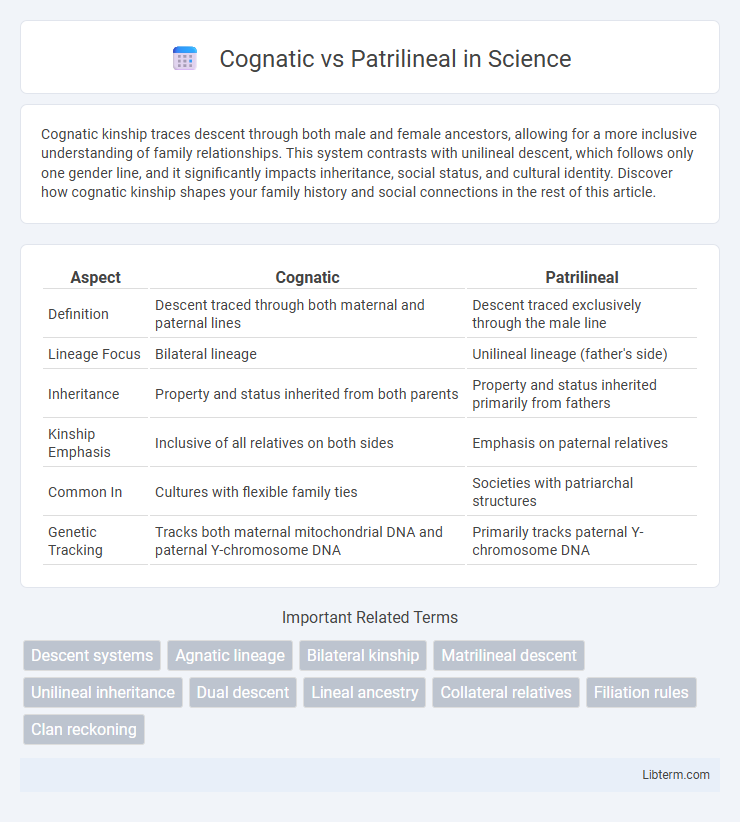Cognatic kinship traces descent through both male and female ancestors, allowing for a more inclusive understanding of family relationships. This system contrasts with unilineal descent, which follows only one gender line, and it significantly impacts inheritance, social status, and cultural identity. Discover how cognatic kinship shapes your family history and social connections in the rest of this article.
Table of Comparison
| Aspect | Cognatic | Patrilineal |
|---|---|---|
| Definition | Descent traced through both maternal and paternal lines | Descent traced exclusively through the male line |
| Lineage Focus | Bilateral lineage | Unilineal lineage (father's side) |
| Inheritance | Property and status inherited from both parents | Property and status inherited primarily from fathers |
| Kinship Emphasis | Inclusive of all relatives on both sides | Emphasis on paternal relatives |
| Common In | Cultures with flexible family ties | Societies with patriarchal structures |
| Genetic Tracking | Tracks both maternal mitochondrial DNA and paternal Y-chromosome DNA | Primarily tracks paternal Y-chromosome DNA |
Introduction to Descent Systems
Descent systems determine lineage and inheritance patterns within societies, with cognatic descent tracing kinship through both maternal and paternal lines, allowing individuals to affiliate with relatives on either side. Patrilineal descent exclusively follows the male line, where inheritance, family name, and social identity pass from father to son. These systems shape social structure, inheritance rights, and cultural identity, influencing how communities organize family ties and property transmission.
Understanding Cognatic Descent
Cognatic descent traces lineage through both male and female ancestors, allowing individuals to inherit rights and status from either side of the family, unlike patrilineal descent which follows only the male line. This system enables more inclusive kinship networks and impacts inheritance, succession, and social identity in various cultures. Understanding cognatic descent reveals complex patterns of familial affiliation and highlights cultural variations in lineage and inheritance practices.
Defining Patrilineal Descent
Patrilineal descent defines lineage through the male line, tracing ancestry and inheritance from father to son, which shapes family structures and social organization in many cultures. This system contrasts with cognatic descent, where lineage can be traced through either male or female ancestors, allowing more flexibility in inheritance and kinship ties. Patrilineal societies often emphasize paternal surname transmission, property rights, and clan membership centered on male lineage continuity.
Historical Context of Lineage Systems
Patrilineal lineage systems, dominant in many ancient and medieval societies such as those in Europe, Asia, and Africa, trace descent through the male line to establish inheritance, social status, and clan membership. Cognatic systems, which recognize kinship through both male and female lines, have historical roots in certain indigenous and matrilineal cultures, offering more flexible family structures and inheritance rules. The evolution of these lineage systems reflects varying social, economic, and political needs within different civilizations, influencing patterns of land ownership, power distribution, and identity formation.
Key Differences: Cognatic vs Patrilineal
Cognatic descent traces lineage through both male and female ancestors, allowing inheritance and family ties from either parent, whereas patrilineal descent traces lineage exclusively through the male line, emphasizing paternal inheritance and ancestry. In cognatic systems, individuals may claim kinship and property rights from both maternal and paternal relatives, promoting more flexible family connections. Patrilineal systems typically prioritize the male lineage for cultural identity, inheritance, and succession, often shaping social structures around male descent.
Societal Impacts of Descent Patterns
Cognatic descent systems trace lineage through both maternal and paternal ancestors, fostering greater social flexibility and inclusive kinship networks, which can lead to more equitable inheritance rights and gender roles. Patrilineal descent patterns emphasize lineage through the male line, often reinforcing patriarchal authority, inheritance concentration among males, and gender-specific social responsibilities. These contrasting descent systems profoundly influence family structure, resource distribution, and gender dynamics within societies.
Inheritance and Property Rights
Cognatic inheritance allows descendants from both maternal and paternal lines to receive property rights, promoting more inclusive family wealth distribution. Patrilineal inheritance restricts property transmission exclusively through the male lineage, concentrating assets within the father's family. Legal frameworks in various cultures enforce distinct rules, impacting land ownership, succession, and gender equity in estate claims.
Cultural Examples Around the World
Cognatic descent, recognized in cultures like the Akan people of Ghana, traces lineage through both maternal and paternal lines, allowing inheritance and social identity from either parent. Patrilineal descent, prevalent among the Maasai of Kenya and many Arab societies, emphasizes lineage and inheritance through the male line, often dictating property rights and family name transmission. These systems profoundly influence social structures, marriage patterns, and inheritance laws across diverse cultural landscapes globally.
Modern Shifts in Descent Traditions
Modern shifts in descent traditions reveal an increasing recognition of cognatic kinship systems, where lineage is traced through both maternal and paternal lines, challenging the historically dominant patrilineal models that prioritize male ancestry. Contemporary societies and legal frameworks are adapting to these inclusive approaches, reflecting evolving values around gender equality and family identity. This transformation influences inheritance laws, social roles, and cultural practices, promoting more balanced recognition of heritage across generations.
Conclusion: Future of Kinship Systems
Kinship systems are evolving as cognatic descent gains prominence, reflecting modern values of inclusivity and flexibility compared to traditional patrilineal structures that emphasize male lineage. The future of kinship is likely to favor hybrid models blending cognatic and patrilineal elements, adapting to diverse family forms and social changes. Demographic trends and shifting cultural norms will continue to influence how descent and inheritance rights are defined globally.
Cognatic Infographic

 libterm.com
libterm.com